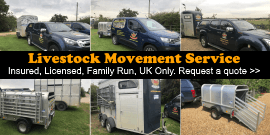Fencing for cattle
Cattle are very hard on fencing. They rub on it, they lean on it, they stick their heads between the strands of wire to get to that elusive clump of grass in the next field – they are very hard on fencing.
A good post and wire fence is sufficient for cattle, but if you have sheep as well, you’ll need stock netting to keep the sheep in – and a leaning cow flattens stock netting quite quickly.
 Robust fencing is needed for cattle. Use two strands of barb, not the one shown here!
Robust fencing is needed for cattle. Use two strands of barb, not the one shown here!
While you may get away with a single plain wire on top for sheep, you really need two strands of barb to stop cattle leaning over the fence – the lower strand will stop them sticking their heads between the stock netting and the top strand.
Now, I don’t like barbed wire, especially since we have ponies, so we’ve gone for a compromise that seems to be working fine. The fences round the perimeter of our smallholding have barbed wire to discourage human intruders – these fences generally have hedges behind them so the ponies would be very unlikely to try to jump them. Internal fences have electric tape rather than barbed wire – this seems to deter the cattle.
I’ve witnessed George touch it with his tongue and I’m pretty sure he won’t do it again. The tapes are in place all the time and we stick the wee electric zapper on the tapes of whichever field the cattle are in.
- Previous « Housing cattle
- Next Multiple-Suckling with Shetland Cattle »

About Rosemary Champion
Rosemary lives on a 12 acre smallholding in Angus, in the east of Scotland, where she keeps Ryeland Sheep, Shetland cattle and assorted poultry. She was destined to be a smallholder from an early age.
Further Reading
 Caring for Cows Val Porter |  Practical Cattle Farming Kat Bazeley |  The Illustrated Guide to Cows Celia Lewis |  Cows for the Smallholder Val Porter |  |













